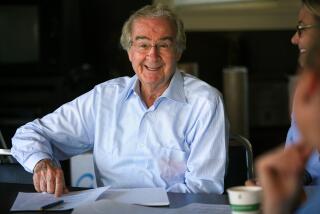Rosier Outlook for Pricey Wine
TO the joy of New Orleans-based sommelier Michael Scherzberg, the cardiologists were in town for a convention earlier this month and were heeding their own advice: Drink red wine.
The doctors were soaking up cult California reds and rare Bordeaux for $400, $500 and more per bottle.
It’s not only traveling physicians but business professionals and others who “are once again starting to spend some real money on wine,” said Scherzberg, of the New Orleans Grill. “We had a 1947 Haut-Brion go out for $1,200.”
With business travel picking up and companies loosening expense accounts, trophy wines -- vintages whose expense and fame identify the buyer as someone with money to burn -- are hinting at a comeback.
At the Fifth Floor restaurant in San Francisco, “Grand Cru days” have returned after a lengthy absence, said sommelier Belinda Chang, as more and more lunch and dinner guests unflinchingly order vintages costing more than the food.
Indeed, the state of the economy has a lot to do with it. “One of our captains really watches the stock market, and he can tell if it is going to be a good day or not,” she said.
Just a few years ago, there were frequent bad days. As the Bay Area’s technology slump took hold, Chang’s customers would page right past the elite vintages to the back of the wine list where bottles for $75 or less were cataloged. Happily for Fifth Floor, she said, “that is starting to change.” Her establishment’s average wine sale now approaches $100, up from $65 a bottle a year ago, Chang said.
Higher-priced wine also may be selling better because restaurant operators from the New Orleans Grill to the Bellagio Resort & Hotel in Las Vegas have cut prices on some of the most exclusive vintages.
Scherzberg dropped the price of a 1959 Latour from $1,800 to $1,200, a markup closer to two times the cost of the bottle than the traditional three. “I would rather sell the wine than just have it sit on the list,” he said.
So far this year at the Bellagio, wine director Jay James is seeing a stronger market for wines in the $300 to $500 range than for the $1,000-plus vintages.
He also credits a nascent recovery in travel from Asia as a factor in the turnaround. “Our Asian customers are big trophy wine drinkers,” James said.
Still, no one in the wine business is popping Champagne corks over a return to the heady days of the late 1990s, when sales of wine at the $60 mark and above grew at an annual average rate of 26%, said industry consultant Vic Motto of MKF Business Advisors in St. Helena, Calif.
Indeed, New York -- once the capital of wine bills the size of the average house payment -- has yet to see a rebound for the elite vintages.
At the Bryant Park Grill in midtown Manhattan, “we rarely sell a bottle of wine for $500 or more these days,” said Michael Weinstein, president of Ark Restaurants Corp., an operator of 24 restaurants in New York, Washington and Las Vegas.
Weinstein fondly remembers one night in 1998 when a group of eight walked into his now-closed Lutece in New York. They spent $25,000 on wine, more than making up for their middling $700 food tab.
That was at the height of the bull stock market and roaring economy, a time when a four-digit wine order was Wall Street’s preferred method for celebrating a big deal or impressing important clients. “I don’t see that happening again,” said Weinstein.
Yet sales of wine for $60 or more -- both at retail outlets and in restaurants -- started to turn up in the second half of last year after hitting bottom in the early months of 2003, said industry consultant Motto. And the signs, he said, point to the trend continuing into 2004.
More to Read
Sign up for The Wild
We’ll help you find the best places to hike, bike and run, as well as the perfect silent spots for meditation and yoga.
You may occasionally receive promotional content from the Los Angeles Times.







